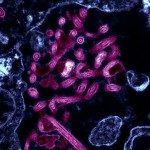Link to Pubmed [PMID] – 24831924
PLoS Negl Trop Dis 2014 May;8(5):e2879
BACKGROUND: Mycobacterium ulcerans (MU) is the agent responsible for Buruli Ulcer (BU), an emerging skin disease with dramatic socioeconomic and health outcomes, especially in rural settings. BU emergence and distribution is linked to aquatic ecosystems in tropical and subtropical countries, especially to swampy and flooded areas. Aquatic animal organisms are likely to play a role either as host reservoirs or vectors of the bacilli. However, information on MU ecological dynamics, both in space and time, is dramatically lacking. As a result, the ecology of the disease agent, and consequently its mode of transmission, remains largely unknown, which jeopardizes public health attempts for its control. The objective of this study was to gain insight on MU environmental distribution and colonization of aquatic organisms through time.
METHODOLOGY/PRINCIPAL FINDINGS: Longitudinal sampling of 32 communities of aquatic macro-invertebrates and vertebrates was conducted from different environments in two BU endemic regions in Cameroon during 12 months. As a result, 238,496 individuals were classified and MU presence was assessed by qPCR in 3,084 sample-pools containing these aquatic organisms. Our study showed a broad distribution of MU in all ecosystems and taxonomic groups, with important regional differences in its occurrence. Colonization dynamics fluctuated along the year, with the highest peaks in August and October. The large variations observed in the colonization dynamics of different taxonomic groups and aquatic ecosystems suggest that the trends shown here are the result of complex ecological processes that need further investigation.
CONCLUSION/PERSPECTIVES: This is the largest field study on MU ecology to date, providing the first detailed description of its spatio-temporal dynamics in different aquatic ecosystems within BU endemic regions. We argue that coupling this data with fine-scale epidemiological data through statistical and mathematical models will provide a major step forward in the understanding of MU ecology and mode of transmission.

